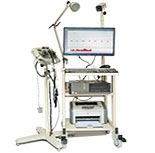Wechat QR code

TEL:400-654-1200

TEL:400-654-1200
What is 24-hour ambulatory blood pressure monitoring?
Publication Date: 2019-02-2600:00 Source: http://www.hnmillion.com Click: 55 more 0
What is 24-hour ambulatory blood pressure monitoring?
For a long time, people have been using sphygmomanometers to measure blood pressure. This method is called occasional blood pressure measurement. Occasional blood pressure measurement plays an important role in finding hypertension patients, guiding the treatment of hypertension, evaluating the prognosis of patients and carrying out preventive health care. But occasional blood pressure measurement still has some shortcomings, for example, some patients in the doctor's office occasionally measured blood pressure has been controlled in the normal range and patients still have target organ damage and cardiovascular disease; some patients in the doctor's office high blood pressure but patients did not appear heart, brain and kidney damage, which makes many hypertensive patients confused. In addition, the inadequacies of occasional blood pressure measurements include: (1) some patients with mild hypertension are prone to delay diagnosis because their blood pressure increases only for some time; (2) the difference between essential hypertension and secondary hypertension can not be put forward from the blood pressure value; (3) the drug can not be used reasonably according to the peak time of blood pressure fluctuation. Because the severity of hypertension and its target organ damage cannot be evaluated more accurately, it is not possible to prevent or reduce target organ damage or cardiovascular disease more effectively. Mellon

To solve the above problems, medical experts use 24-hour ambulatory blood pressure monitoring for hypertensive patients to grasp the law of blood pressure changes. Many years of medical practice has proved that the application of 24-hour blood pressure monitoring can overcome the above problems existing in occasional blood pressure measurement. The majority of hypertensive patients and their families have the basic knowledge of 24-hour blood pressure monitoring and its clinical significance. It is of practical significance to further understand their own diagnosis, treatment and preventive health care work. Therefore, 24-hour blood pressure monitoring should be fully used in the practice of diagnosis and treatment of hypertension. The so-called 24-hour blood pressure monitoring is to wear a specific ambulatory blood pressure recorder on the upper limbs and chest of the subjects. The instrument automatically and regularly records the 24-hour blood pressure of the subjects, and discovers the changes of blood pressure in their daily activities (such as exercise, exercise, work, life, rest and sleep). Mellon
Mellon
Medical research has proved that people's blood pressure is fluctuating, and the fluctuation is regular. 70% of patients with hypertension have two peaks and valleys, the so-called "spoon blood pressure". The first peak is around 8:00 in the morning, and then the blood pressure begins to drop. Because of the noon break, there are often daytime low blood pressure valleys between 12:00 and 1:00 in the afternoon. After 2:00 in the afternoon, the blood pressure starts to rise again, and it is a big peak around 6:00 in the afternoon. Then the blood pressure begins to drop, reaching its lowest point at 12:00 in the middle of the night, and then the blood pressure rises again on the next day. Twenty-five percent of patients had only one peak in the afternoon and no peak in the morning. Especially in a few (5%) patients with hypertension, there is only one peak in the morning, but no peak in the daytime and afternoon.
Therefore, the method of ambulatory blood pressure monitoring can successfully solve the above two examples. Moreover, 24-hour blood pressure monitoring can detect hypertension patients and "white coat hypertension" early, and help to identify secondary hypertension.
Some hypertensive patients have elevated blood pressure only at 6-8 a.m. or 6-8 p.m. and it is easy to miss diagnosis if they only rely on occasional blood pressure measurements during working hours (8 a.m. to 5 p.m.). Therefore, 24-hour ambulatory blood pressure monitoring should be carried out for suspected hypertensive patients, or blood pressure should be measured at two blood pressure peaks, and hypertensive patients should be found in time.
There are also some patients with hypertension because of psychological factors or emotional tension, found in the doctor's office when testing hypertension, even after receiving several drugs, blood pressure is difficult to control, manifested as refractory hypertension. If these patients are allowed to observe their own blood pressure at home is not high, 24-hour ambulatory blood pressure monitoring found only in the hospital when the blood pressure is high, and after leaving the hospital the blood pressure is completely normal, known as "white coat hypertension". Once these patients understand the cause of their high blood pressure, they will eliminate tension and irritability, and actively cooperate with the doctor for treatment. Ideal therapeutic effect can be achieved by timely discovering patients with "white coat hypertension" and adjusting their lifestyle and properly choosing antihypertensive drugs, which is of practical significance for reducing the economic burden of patients and avoiding unnecessary adverse drug reactions.
It is well known that in untreated hypertensive patients, a series of pathological changes can occur in the heart, brain, kidney and other important organs, such as left ventricular hypertrophy, heart failure, coronary heart disease, cerebral thrombosis, cerebral hemorrhage and so on. The incidence and severity of these diseases are closely related to blood pressure, especially with 24-hour mean blood pressure and night mean blood pressure. The higher the mean systolic and diastolic blood pressure, the more serious the damage to target organs. Studies have shown that patients with average ambulatory blood pressure below 120/80 mmHg rarely suffer from target organ damage of hypertension, and those with average ambulatory blood pressure above 160/100 mmHg may suffer from target organ damage of hypertension to varying degrees.
The effect of nocturnal elevated blood pressure on heart, brain and kidney is more serious than that of accidental elevated blood pressure. For example, patients with elevated blood pressure at night are prone to left ventricular hypertrophy, which is an independent risk factor for cardiovascular disease and death. Prevention and timely detection and reversal of left ventricular hypertrophy are important advances in antihypertensive therapy in recent years. Therefore, the prevention and reversal of left ventricular hypertrophy should be done well in patients with elevated blood pressure at night by ambulatory blood pressure monitoring in order to further prevent coronary heart disease.